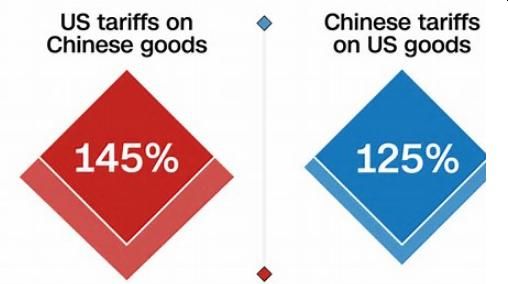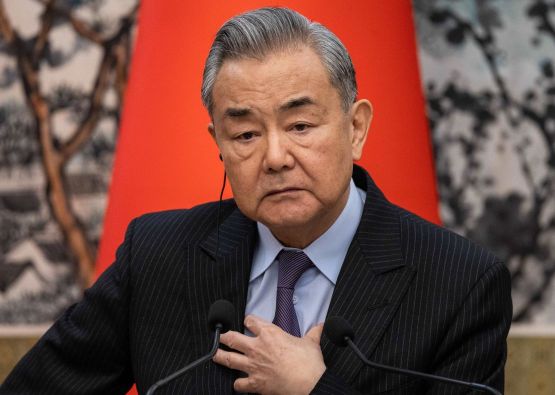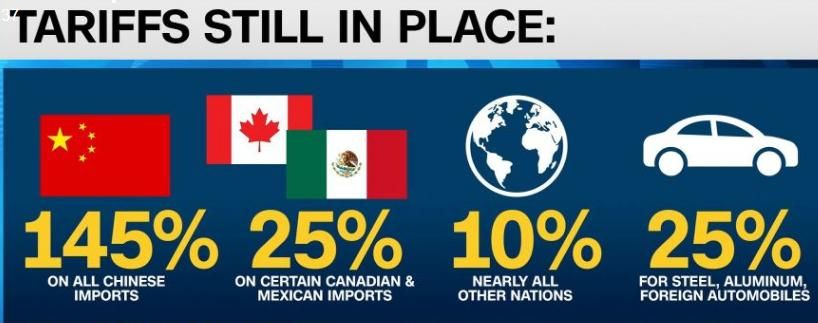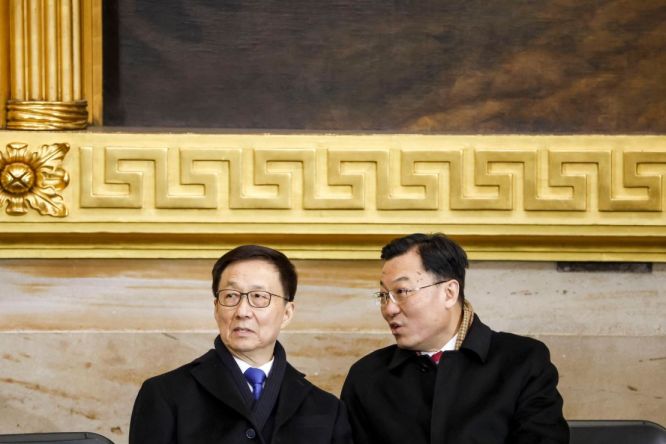By Eric Vandenbroeck and co-workers
Today's 'Tariff War'
A reason why
President Xi is seen smiling when faced with Trump's onslaught is because
China, during the last decade, has faced this many times before and always came
on top of it which led to President Xi Jinping’s vision for the “Great
Rejuvenation of the Pan-Chinese Nation” and “China Dream” emphasizes a shared
ancestry and cultural identity among ethnic Chinese, both within China and
abroad.
Whereby most recently
a so-called 'tariff war' ensued when on on
Friday April 11, Beijing issued a sharp rebuke of the Trump administration's
trade tactics. In a post from its official account, China's Ministry of Foreign
Affairs accused the U.S. of "capricious and destructive behavior" and
vowed not to bow to American pressure. The statement follows days of tariff
announcements and warnings from both countries.
After three months of
insulting, tariffing, and even threatening to annex some of its best allies,
the Trump administration suddenly needs some help.

A tariff
reprieve from President Donald Trump sent global markets soaring on
Wednesday, with the White House saying it’s been in touch with dozens of
countries about striking deals, lining up calls and meetings in the coming
weeks.
But one country was
conspicuously absent from any outreach: China. Even Xi Jinping might have to
persuade his people that the pain is worth it. Rather than a fight on all
fronts against the world, this now looks far more like a fight on familiar Trumpian
territory: America vs. China.
As the rest of the
world received a 90-day respite, Trump escalated tariffs on China, saying the
US would now charge an extra 145% on all Chinese goods that arrive in the US.
In response, Beijing ratcheted up its tariffs on American goods Friday to 125%,
and the country’s leader — who Trump is urgently working to engage — warned
China was “not afraid” of a prolonged trade conflict.
In private
discussions hours before China announced new retaliatory tariffs, the Trump
administration warned Chinese officials against such a move, according to a
source familiar with the discussions.
The Chinese were also
told – once again – that Chinese President Xi Jinping should request a call
with US President Donald Trump.
Instead, US officials
woke up to news of increased Chinese tariffs and no request for a leader-level
call. Xi also made comments that only dug him in further.
“For over 70 years,
China’s development has relied on self-reliance and hard work — never on
handouts from others, and it is not afraid of any unjust suppression,” Xi said,
according to state broadcaster CCTV, during his meeting with the Spanish prime
minister.
An unprecedented
trade war between the world’s two economic superpowers is quickly taking shape,
with both countries waiting for the other to blink.
Two senior White
House officials tell CNN that the US will not reach out to China first. Trump
has told his team that China must be the first to make the move, as the White
House believes it is Beijing that has chosen to retaliate and further escalate
the trade war.
One hurdle, Trump’s
team believes, is Xi’s desire not to be seen as weak by making the first move
and approaching the US for talks.
Trump, who envisions
a grand bargain with China that increases US exports, cracks down on fentanyl
exports and restructures TikTok for US users, has suggested Beijing would come
around.
“China wants to make
a deal. They just don’t know how quite to go about it,” Trump said on Wednesday
during an event at the White House. “You know, it’s one of those things they
don’t know quite – They’re proud people.”
Looking for the proper channel
But for months, US
and Chinese leaders have been talking past each other, allowing relations to
sour as each country’s overtures go unanswered.
Behind the scenes,
official channels at the working level are active, but high-level dialogue has
not been happening. Meanwhile, unofficial channels have proven unproductive,
according to three sources briefed on the situation, paving the way for a game of
economic chicken with a costly and uncertain end.
China’s reliance on
strict protocol and desire to prepare Xi for any call of this magnitude is
fundamentally at odds with how Trump does business, some current and former
officials say, which they point to as the main 'hangup' in trying to get
productive talks underway.
China has been trying
to set up a back channel like it had with President Joe Biden’s national
security adviser, Jake Sullivan, but so far, that effort has been unsuccessful.
The US objection, according to officials: The Trump administration has balked
at China’s Foreign Minister Wang Yi serving as the interlocutor, suggesting
that Wang is not close enough to Xi’s inner circle and cannot be trusted.

Chinese Foreign
Minister Wang Yi attends a press conference with French Foreign Minister
Jean-Noel Barrot at Diaoyutai State Guest House on March 27 in Beijing.
Chinese officials
have been presented with the specific names of people that the Trump White
House would like to engage with instead, but China won’t budge, sources say.
Further inflaming
tensions, the Chinese readout of a call between Wang and Secretary of State
Marco Rubio earlier this year appeared to misrepresent the contents of the
call, Rubio later said.
“That didn’t happen,
at least not on the call, or at least maybe their interpreter didn’t want to
interpret it that way,” Rubio said of the Chinese claim that Rubio was warned
not to overstep himself.
While some
communication between the sides has been brokered by China’s ambassador to the
US, the dearth of a principal-level channel has been problematic in arranging a
call that the Trump administration says is necessary.
Two senior White
House officials told CNN that Trump would be happy for communication to begin
below the leader-level if it brought about results.

Despite Trump
officials publicly saying that Trump will dictate his engagement with Xi –
National Economic Council Director Kevin Hassett said on CNBC Thursday morning
that Trump “will decide” when conversations begin – it is clear that the ball
is in China’s court for the time being.
At least, that’s how
Trump officials see it. But that’s not the view in Beijing.
“The door to talks is
open, but dialogue must be conducted based on mutual respect and equality,” a
spokesperson for the Chinese Commerce Ministry said Thursday. “If the US
chooses confrontation, China will respond in kind. Pressure, threats, and
blackmail are not the right ways to deal with China.”
Amid the standoff,
the White House has sought to prioritize trade deals with Japan, South Korea,
and Vietnam to pressure Beijing, a senior White House official said.
Current and former US
officials aren’t ruling out the possibility of putting in place an unexpected
preparation channel for a possible Xi-Trump call, but former US officials say
the key is ensuring the Chinese they aren’t sending Xi in for an ambush — especially
after the tongue-lashing Ukrainian President Volodymyr Zelensky received in the
Oval Office.
“The Chinese, in any
case, are reluctant to put their leader in the position that Zelensky found
himself in,” said Danny Russel, a former assistant secretary of State for East
Asia and currently vice president of the Asian Society Policy Institute. “They
want to ensure that some of the groundwork is laid for a meeting and that
there’s some ground rules established.”
‘Mutually-assured destruction’
Chinese officials
have sought avenues to reach Trump directly, often through business leaders who
have his ear.
When Xi dispatched
Vice President Han Zheng to Washington as the highest-ranking Chinese envoy to
ever attend a presidential swearing-in, Han also took a meeting with Elon Musk.

Han Zheng, left, Vice
President of the People's Republic of China, attends Donald Trump's
inauguration as the next President of the United States at the US Capitol on
January 20.
Influence in the
early days of the Trump administration. Chinese officials had hoped to
establish more direct lines of communication with the new Trump administration,
using Musk as an intermediary, one person familiar with the matter said. But so
far, those attempts haven’t been fruitful.
China has considered
kneecapping the operations of blue-chip US companies in China, such as Apple,
Tesla, Caterpillar, and Starbucks. Ultimately, according to two sources briefed
on the discussions, Beijing backed off that idea – worried that Chinese consumers
would revolt and the Chinese Communist Party could lose the potential for
lucrative executive backchannels.
But the CCP is still
weighing strategic options to hit back against Washington beyond simply raising
import duties. China will likely begin buying soybeans and agricultural
products from Brazil instead of the US heartland, as it did during Trump’s
first-term trade war.
“Look at where
they’re blacklisting US companies, hitting US farmers, cutting us off from
critical minerals – that’s a toolkit that they’re very comfortable wielding,”
said Melanie Hart, senior director of the Atlantic Council’s Global China Hub.
“They have experimented with it in many other countries. They’ve been
developing it for years. They have a bunker that they’ve been building for this
moment.”
Asked what pain
threshold either country is willing to bear, sources in touch with both
governments couldn’t say. But one thing is clear: How far either country moves
into leveraging non-tariff weapons to fight back could determine how dangerous
the economic conflict becomes.
Beijing has banned
the export of a handful of rare earth minerals required for manufacturing
certain goods. Moving to ban the export of all rare earth minerals or selling
off the mountain of US Treasury bonds it has amassed would be seen as taking
the conflict to the next level.
“If China moves to
fully throttle the US economy, all shackles are off,” said a former US official
briefed on the state of play. “A trade war of that magnitude is an act of war.”
Which country has
more leverage in such a conflict depends on whom you ask. Peter Navarro,
Trump’s uber-hawk, has suggested Beijing can’t afford to escalate to that
level. Others suggest that’s a naive depiction of an authoritarian leader
wielding the full power of a non-market economy subsidized by his government.
“That’s incorrect,”
one source in touch with both governments suggested of Navarro’s belief. “This
is going to be mutually assured destruction.”
Some experts suggest
it’s Xi who has the upper hand, having bolstered his political standing at home
and earning more room to maneuver before engaging Trump.
“Xi Jinping is in a
much stronger political position as a result of the perceived attacks by the
Trump administration, and he is in a better position to convince the Chinese
people to absorb whatever economic pain the tariffs may cause,” Russel said.
Matt Pottinger, who
served as Trump’s deputy national security advisor, and Liza Tobin, who served
as his China director on the National Security Council, described the
divide in the Free Press as a “messy breakup” and a “zero-sum contest”
whose settlement will bring consequences for the rest of the world. The
superpowers, they said, are evenly matched – but have different goals.
“While Trump has
seized the upper hand in the trade war, Xi is gaining ground in areas that may
be even more consequential: artificial intelligence, advanced manufacturing,
and the military might required to seize the most
important piece of real estate in the world – Taiwan.”
Trump’s first term regrets
During Trump’s time
out of office after his loss in 2020, he frequently brooded about the
shortcomings of the trade agreements he struck with China during his first
term. While he enjoyed a warm relationship with Xi, including a Xi visit to
Mar-a-Lago and a splashy Trump visit to Beijing in 2017, their partnership
soured in the latter years of his first term.
Trump has bemoaned
what he said were weak officials who allowed China to renege on some the
agreements it made to purchase large amounts of American goods, including
agricultural products. China has cited the Covid pandemic as the reason it did
not fulfill the terms of the deal.
Back in office, Trump
has discussed striking a more wide-ranging deal with China that would extend
beyond trade to other areas of potential cooperation, such as new investments
and commitments by China to buy more American products. Complicating that effort
is the fact that a first-term trade deal aimed at selling more to China has
yielded little result, and Trump’s hawkish national security team previously
has expressed reservations about letting Beijing invest more in the US.
Trump also came into
office vowing to crack down on fentanyl coming from China to the US. In his
first days in office, Trump imposed a 10% tariff on China – along with threats
and tariffs on Canada and Mexico – citing the role of Chinese suppliers in the
fentanyl trade.
Shortly after a
conversation between Trump and Xi in mid-January, the CCP submitted a proposal
related to curbing fentanyl production to the US Embassy in Beijing. The
embassy did not respond to the proposal, which it privately derided. Beijing
was furious, according to a source familiar with the two governments.
Last week, Beijing
came forward with a more substantial offer after the administration had been
pushing them to do so. But it remains to be seen whether Trump would seriously
consider that proposal – and any movement toward a TikTok deal – as a way to knock
down tariffs that have risen exponentially and cleaved the two countries’
economies.
“Might Trump’s
dealmaking instinct reassert itself and overtake his decoupling instinct?”
Pottinger and Tobin asked. “But a comprehensive ‘grand bargain’ that sets aside
the US-China arch-rivalry has never been more distant.”
For updates click hompage here